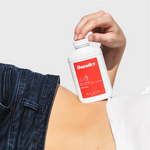Upper lip and facial sweating can be embarrassing and can affect a person's social life. People with upper lip sweat problems experience discomfort in the lip and mouth area and struggle with normal social interactions.
If you are one that struggle with this situation you are not alone. Let’s see which are the common causes and how to handle this stressful situation.
Primary Focal Hyperhidrosis
Sweating in the upper lip is a kind of craniofacial sweating, which is a sub-type of hyperhidrosis that affects the head, face, and scalp. Typically, most craniofacial problems are caused by Primary Focal Hyperhidrosis.
It´s hard to identify the exact reason for this sweating problem since it is not caused by any underlying medical condition. Most of the time, PFH occurs when there is an increase in the activity with the nerves that send signals to the body and leads to overactive sweat glands.
Doctors say that Primary Focal Hyperhidrosis is likely to start showing in adolescence, between the ages of 14 and 25 years old. Hyperhidrosis is also believed to have an hereditary component and can be passed down among families who have a history of excessive sweating.
Other possible reason for Sweating profusely can be stress or anxiety attacks. When you’re under any kind of stress, your body’s temperature rises and it reacts by prompting your sweat glands to release the fluid in your hands, nape, or the temple.
A common cause of upper lip and facial sweating is stress. Many people experience excessive sweating during times of high stress. This condition can also be caused by self-consciousness. It is important to address the causes of your sweating and find a treatment that will help you overcome them. The best way to stop sweating is to reduce your stress levels.
Usually People diagnosed with PFH often report that they experience Excessive sweating in the underarm (axillary hyperhidrosis), hands, feet, and even groin for more than 6 months and their sweating interrupts their quality of life.

How to Get Rid of Upper Lip and Face Sweat?
When lifestyle changes, like avoiding spicy foods or warm environments,aren't enough, it's worth talking with your doctor or a dermatologist.
Basically the treatments are the same as for any other subtype of hyperhidrosis.
Some treatments are topical creams and medications that can reduce facial sweating. There are also surgical procedures. Cosmetic surgeons can perform a procedure known as an ETS (endoscopic thoracic sympathectomy) to treat facial sweating. Laser treatments are another option, they help to reduce facial blushing and sweating.
Other treatments involve oral medications. Anticholinergics, such as oxybutynin hydrochloride, reduce sweat production by blocking nerve impulses to the sweat glands. These treatments can also be effective in suppressing anxiety, a common trigger for excessive facial sweating. However, they may cause a number of side effects, such as blurred vision, dizziness, and dry mouth.
Treatments for facial sweating vary depending on the extent of the problem, the location, and severity of the sweat. Some dermatologists offer medication like Botox injections to control the condition. Injections of sweat stoppers may be helpful for patients with extensive sweating on the upper lip and forehead. While these are not the ideal treatments for this condition, they can help some sufferers.
Managing Makeup With Upper Lip Sweat
Using a primer underneath foundation or concealer can give your makeup more staying power, as can setting your makeup with a powder or spray afterwards.
Don't be afraid to give your upper lip a quick blot with a tissue when you notice those sweat beads starting to form.



